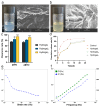Fabrication and Characterization of Phyllanthus Emblica Extract-Polyvinyl Alcohol/Carboxymethyl Cellulose Sodium Antioxidant Hydrogel and Its Application in Wound Healing
- PMID: 39771510
- PMCID: PMC11678665
- DOI: 10.3390/pharmaceutics16121531
Fabrication and Characterization of Phyllanthus Emblica Extract-Polyvinyl Alcohol/Carboxymethyl Cellulose Sodium Antioxidant Hydrogel and Its Application in Wound Healing
Abstract
Background: Phyllanthus emblica is a medicinal and edible plant from the Euphorbiaceae family, notable for its rich content of polyphenols and flavonoids, which provide significant antioxidant properties. To exploit the full antioxidant potential of Phyllanthus emblica, this study developed a hydrogel system incorporating polyvinyl alcohol (PVA) and carboxymethyl cellulose sodium (CMC-Na), integrated with Phyllanthus emblica extract, for the purpose of wound healing. Methods: The extraction process of active ingredients of Phyllanthus emblica was optimized and assessed the antioxidant composition and activity of the extract. A series of hydrogel performance evaluations were performed on the Phyllanthus emblica extract-loaded PVA/CMC-Na hydrogel (AEPE composite hydrogel). Additionally, the wound healing efficacy was evaluated through cell culture experiments and wound healing assays using BALB/C mice. Results: The findings indicated that the extraction of Phyllanthus emblica with 95% ethanol yielded an extract rich in polyphenols, primarily gallic acid and ellagic acid, demonstrating high free radical scavenging capacity and robust antioxidant activity. The hydrogel matrix containing 12% PVA and 1% CMC-Na exhibited excellent physicochemical properties. The optimized AEPE composite hydrogel enabled sustained drug release over a 24 h period, exhibited low cytotoxicity and promoted cell migration. In a mouse dorsal wound healing model, the AEPE composite hydrogel showed pronounced anti-inflammatory and antioxidation effects, enhanced collagen deposition, and ultimately accelerated wound healing. Conclusions: The AEPE composite hydrogel demonstrated strong antioxidant characteristics and significant wound healing potential. Thus, this study could broaden the application prospects of Phyllanthus emblica in wound healing.
Keywords: PVA/CMC-Na hydrogel; Phyllanthus emblica; anti-inflammatory; antioxidant; gallic acid; polyphenol; sustained release; wound healing.
Conflict of interest statement
The authors declare no conflicts of interest.
Figures





Similar articles
-
HPLC fingerprint analysis of Phyllanthus emblica ethanol extract and their antioxidant and anti-inflammatory properties.J Ethnopharmacol. 2020 May 23;254:112740. doi: 10.1016/j.jep.2020.112740. Epub 2020 Mar 6. J Ethnopharmacol. 2020. PMID: 32151757
-
Purification of polyphenols from Phyllanthus emblica L. pomace using macroporous resins: Antioxidant activity and potential anti-Alzheimer's effects.J Food Sci. 2022 Mar;87(3):1244-1256. doi: 10.1111/1750-3841.16028. Epub 2022 Feb 4. J Food Sci. 2022. PMID: 35122250
-
One-Pot and Green Preparation of Phyllanthus emblica Extract/Silver Nanoparticles/Polyvinylpyrrolidone Spray-On Dressing.Polymers (Basel). 2022 May 29;14(11):2205. doi: 10.3390/polym14112205. Polymers (Basel). 2022. PMID: 35683878 Free PMC article.
-
The Phyllanthus emblica Fruits: A Review on Phytochemistry Traditional Uses, Bioactive Composition and Pharmacological Activities.Curr Top Med Chem. 2024;24(22):1917-1939. doi: 10.2174/0115680266321320240708060327. Curr Top Med Chem. 2024. PMID: 39069705 Review.
-
Traditional uses, bioactive composition, pharmacology, and toxicology of Phyllanthus emblica fruits: A comprehensive review.J Ethnopharmacol. 2022 Jan 10;282:114570. doi: 10.1016/j.jep.2021.114570. Epub 2021 Sep 2. J Ethnopharmacol. 2022. PMID: 34480995 Review.
Cited by
-
Engineered Hydrogels for Musculoskeletal Regeneration: Advanced Synthesis Strategies and Therapeutic Efficacy in Preclinical Models.Polymers (Basel). 2025 Jul 30;17(15):2094. doi: 10.3390/polym17152094. Polymers (Basel). 2025. PMID: 40808142 Free PMC article. Review.
References
-
- Wu M., Liu M., Wang F., Cai J., Luo Q., Li S., Zhu J., Tang Z., Fang Z., Wang C., et al. The inhibition mechanism of polyphenols from Phyllanthus emblica Linn. fruit on acetylcholinesterase: A interaction, kinetic, spectroscopic, and molecular simulation study. Food Res. Int. 2022;158:111497. doi: 10.1016/j.foodres.2022.111497. - DOI - PubMed
Grants and funding
LinkOut - more resources
Full Text Sources
Miscellaneous

